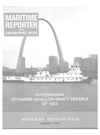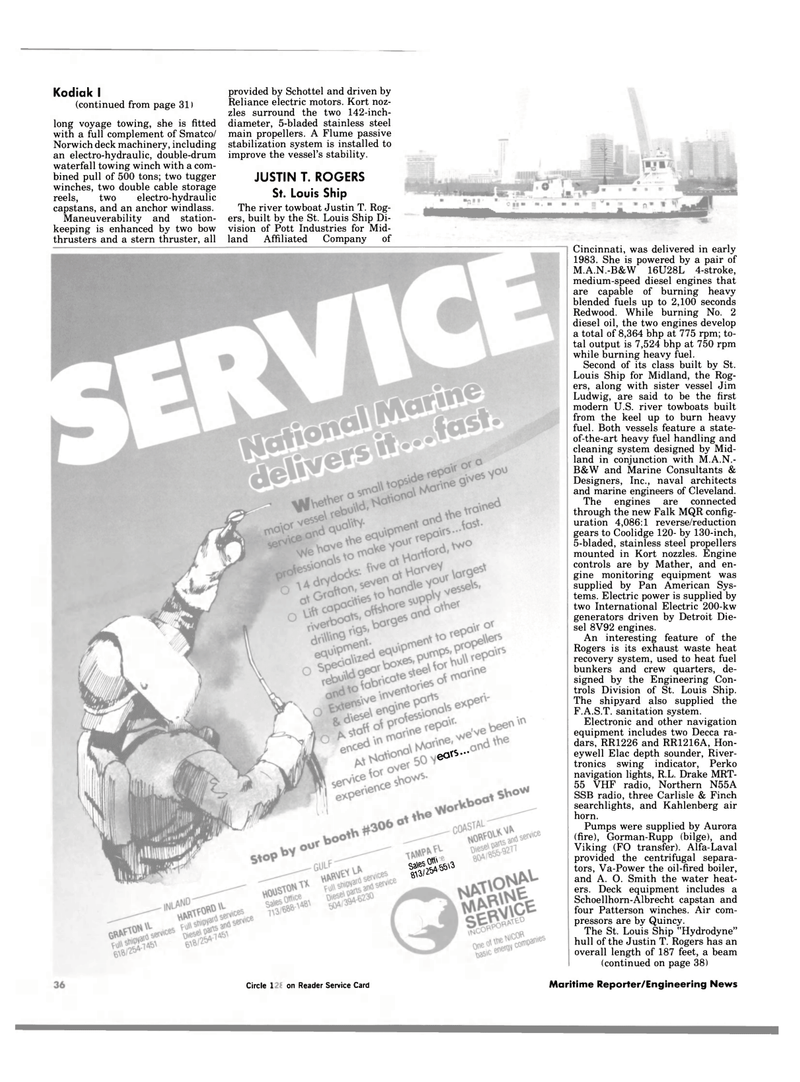
Page 36: of Maritime Reporter Magazine (January 1984)
Read this page in Pdf, Flash or Html5 edition of January 1984 Maritime Reporter Magazine
Kodiak I (continued from page 31) long voyage towing, she is fitted with a full complement of Smatco/
Norwich deck machinery, including an electro-hydraulic, double-drum waterfall towing winch with a com- bined pull of 500 tons; two tugger winches, two double cable storage reels, two electro-hydraulic capstans, and an anchor windlass.
Maneuverability and station- keeping is enhanced by two bow thrusters and a stern thruster, all provided by Schottel and driven by
Reliance electric motors. Kort noz- zles surround the two 142-inch- diameter, 5-bladed stainless steel main propellers. A Flume passive stabilization system is installed to improve the vessel's stability.
JUSTIN T. ROGERS
St. Louis Ship
The river towboat Justin T. Rog- ers, built by the St. Louis Ship Di- vision of Pott Industries for Mid- land Affiliated Company of eof*-' aft*8
Cincinnati, was delivered in early 1983. She is powered by a pair of
M.A.N.-B&W 16U28L 4-stroke, medium-speed diesel engines that are capable of burning heavy blended fuels up to 2,100 seconds
Redwood. While burning No. 2 diesel oil, the two engines develop a total of 8,364 bhp at 775 rpm; to- tal output is 7,524 bhp at 750 rpm while burning heavy fuel.
Second of its class built by St.
Louis Ship for Midland, the Rog- ers, along with sister vessel Jim
Ludwig, are said to be the first modern U.S. river towboats built from the keel up to burn heavy fuel. Both vessels feature a state- of-the-art heavy fuel handling and cleaning system designed by Mid- land in conjunction with M.A.N.-
B&W and Marine Consultants &
Designers, Inc., naval architects and marine engineers of Cleveland.
The engines are connected through the new Falk MQR config- uration 4,086:1 reverse/reduction gears to Coolidge 120- by 130-inch, 5-bladed, stainless steel propellers mounted in Kort nozzles. Engine controls are by Mather, and en- gine monitoring equipment was supplied by Pan American Sys- tems. Electric power is supplied by two International Electric 200-kw generators driven by Detroit Die- sel 8V92 engines.
An interesting feature of the
Rogers is its exhaust waste heat recovery system, used to heat fuel bunkers and crew quarters, de- signed by the Engineering Con- trols Division of St. Louis Ship.
The shipyard also supplied the
F.A.S.T. sanitation system.
Electronic and other navigation equipment includes two Decca ra- dars, RR1226 and RR1216A, Hon- eywell Elac depth sounder, River- tronics swing indicator, Perko navigation lights, R.L. Drake MRT- 55 VHF radio, Northern N55A
SSB radio, three Carlisle & Finch searchlights, and Kahlenberg air horn.
Pumps were supplied by Aurora (fire), Gorman-Rupp (bilge), and
Viking (FO transfer). Alfa-Laval provided the centrifugal separa- tors, Va-Power the oil-fired boiler, and A. O. Smith the water heat- ers. Deck equipment includes a
Schoellhorn-Albrecht capstan and four Patterson winches. Air com- pressors are by Quincy.
The St. Louis Ship "Hydrodyne" hull of the Justin T. Rogers has an overall length of 187 feet, a beam (continued on page 38) 12
Circle 109 on Reader Service Card Maritime Reporter/Engineering News

 35
35

 37
37
